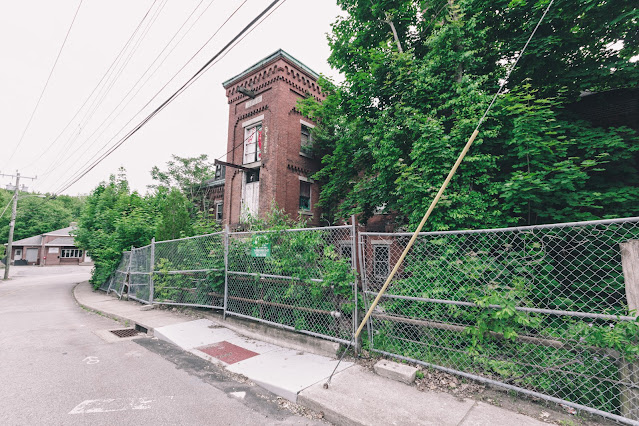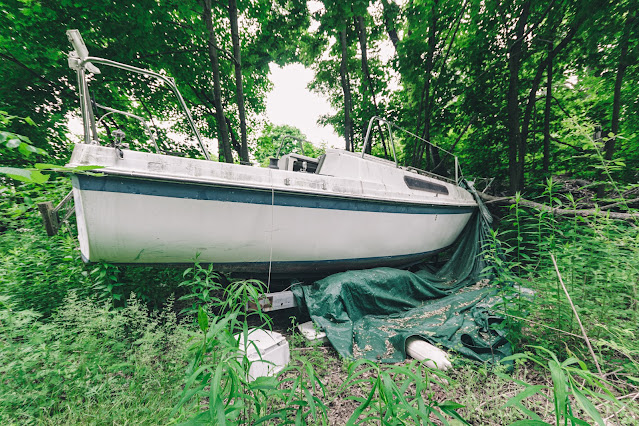Stillmanville Woolen Mill (Connecticut Castings Mill)
 |
| Exterior of Stillmanville Mill from the street. |
Approaching the Connecticut Castings Mill also known as the Stillmanville Mill there were about three vacant boats lined up on the pathway to the mill in various states of disrepair and conditions. From time to time I have found various forms of recreational vehicles at various mills across the Eastern seaboard. From old cars to aquatic vehicles, I have found at least one vehicle whether stripped down to its frame or fully left to rot like it was left a few months ago. Mills always have something sequestered within the old decaying spaces within its walls. This mill was no different.
 |
| One of my favorites from here. |
 |
| "Let me drive the boat" in my best Kodak Black voice |
Stillmanville would not be so named if it was not for the man known today as Oremus M. Stillman who established the industrial neighborhood as Rhode Island became the forefront of the American Industrial Revolution.
Along with where Canal Street runs, Samuel Brand built a woolen mill roughly half a mile north of downtown Westerly around 1798. The town population at the time was a mere 15 people. Canal Street as its name was derived was actually a canal that was built by Pawcatuck Manufacturing Company to increase hydropower capacity. Unfortunately, the canal was filled in and built over. Today it is now known as Canal Street.
In the early 1800s, John Schofield, an Englishman, acquired the saw and linseed oil mill built by John Congdon before being purchased by Oremus M. Stillman in 1831 who added a woolen mill. Mr. Stillman replaced the original mill building in 1848 with two three-story red brick buildings. The Woolen mill was then purchased by F.R.White and Company, which maintained an extensive woolen goods plant opposite the Stillmanville mill east of the Pawcatuck River in Westerly, Rhode Island. In 1880, Warren O. and Louis. W. Arnold purchased the firm and renamed it the Westerly Woolen Company. The brothers made substantial improvements to the land and even demolished the former Stillmanville Woolen Mill during the mid-2010s. In 1912, the Westerly Woolen Mill was liquidated in auction 1912 after being in operation since 1881 employing 450 people across two dozen buildings up until the early 1910s.
You can see a stereograph of the Stillmanville here.
Eventually, the property's last purpose was a foundry that occupied and operated on both state lines the Connecticut Casting Corporation in Connecticut and Westerly Casting Company in Rhode Island. The factory sits on the west bank of the Pawcatuck River and abuts the ruins of the former stone dam that provided power in the early days of Stillmanville Mill.
However, in 2005, the mill was supposed to be developed into apartments but was ultimately shelved in the 2007 economic downturn. A Worcester Massachusetts development firm was supposed to redevelop the site into 18,000 square foot lot. The property has sat vacant for over 20 years due to its designation as a brownfield site which can add considerable costs in demolition and remediation before even the foundation can be poured. The site was used as stated before an oil and sawmill, a woolen mill, a waste handling company, and a laundry and metal castings factory. The latter closed down in the late 1990s.
In April 2019, the mill was demolished due to its deteriorating condition and possible imminent collapse and contamination of the Pawcatuck River.
 |
| Quantaspec Vaccum X-Ray Spectrograph machine. |
 |
| Casting equipment and industrial residue. |
 |
| Either the window was removed or an intricate window piece was taken from here. |
 |
| The top floor of Stillmanville Mill |
 |
| Looking at the mill from the bridge sidewalk. |
Location: 75 Stillman Ave, Pawcatuck, Stonington, CT
Status: Demolished April 2019
Sources:
1. Vallee, Jason, "Stonington secures brownfield grants for Mystic Boathouse Park, Stillmanville testing", June 28, 2021, The Westerly Sun
2. "Stillmanville: Westerly's Lost Village", SeeWesterly
3. Sommer, Carol, "Innovators in industry and the arts: the Scholfield's", January 20, 2019, The Day
4. Ferreira, Nicholas & Platow, Madison, "Former Stillmanville Mill Remediation Project for the Town of Stonington, CT", April 2020, UCONN School of Engineering
5. Stillmanville Mill Property Abandonment Report, Town of Stonington Department of Planning, November 4, 2018, Stillmanville Mill
6. Valle, Jason, "Town denied access to old casting mill site", January 30, 2020, The Westerly Sun
7. Wojtas, Joe, "Demolition continues on Pawcatuck Mill", April 16, 2019, The Day
8. Wojtas, Joe, "Stonington begins to demolish collapsing mill", April 15, 2019, The Day
#abandonedmill #mill #abandonedconnecticut #abandonedrhodeisland #CT #RI #urbex #urbexexploration #abandonedmachinery #urbexconnecticut #urbexrhodeisland





















Comments
Post a Comment